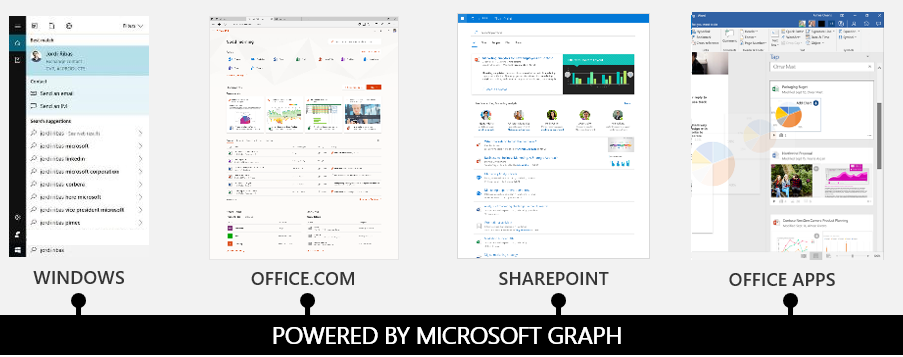Without lots of configuration, search at work has traditionally been a fairly underwhelming experience. All that’s changing with Graph, Microsoft’s ground-up reimagining of how we can find things.

Findability has always been a huge issue for organisations. Whenever we interview people ahead of a new intranet or digital workplace project, underperforming search is often the number one complaint. As people generate more and more information over the course of their working lives, the chances of ‘classic’ search systems returning useful results diminish. To address this, technologists are thinking laterally, redesigning how search works from the ground up.
Having a graph
Office 365 now has more than 100 million active commercial users, who make 50 million hours of Skype calls every day, arrange more than two billion meetings per month and send trillions of emails. With so much happening on their platforms, Microsoft have started treating data about how Windows 10 and Office 365 are being used as an extremely valuable commodity. Internally, that insight is being used to make constant improvements to the apps we use every day. Office 365 is already on a subscription model, and Windows 10 is heading that way; that means Microsoft can push out regular user experience tweaks and feature updates to their software without any action required on the part of the user.
The intelligence generated by all those user interactions is also being used to make huge advances in findability, improving search and even pre-empting what users are looking for. It’s giving users an ever-improving, more personalised, useful and satisfying search experience. That’s all happening thanks to something called the Microsoft Graph.
Layers of insight
Graph emerged from the idea of improving search by considering “social distance” – how closely-connected people are to each other. This idea has been around for a while in SharePoint, where search results from your colleagues – people you work with directly, who you report to, or who report to you – would be returned ahead of others. Graph considers your colleagues, contacts, and group memberships to determine the connections most important to your work.

On top of that first layer, Microsoft added insight into the content you work with. This includes knowledge about the documents you are working on – who else has edited those documents; who you shared files with; who you co-authored presentations with. Through Outlook, it also takes into account the emails you send and what’s in your calendar.
The third layer is the conversations you have – whether that’s on Yammer, Skype, Teams or any of the other channels provided by Windows and Office 365. Graph sees who you talk to, and uses that information to identify the people with whom you really work most closely.
This is only made possible by the deep integration of every part of Office 365, and it means that however your organisation uses the platform, your search experience will be enriched by metadata you unconsciously generate every day.
Rich and interconnected
Taken together, this rich, interconnected data lets us create systems that find the documents, people and conversations most relevant to each individual. Everyone’s search results will be different, but they will also be the best possible search results for that person. And the quality of search results will improve the more each person uses their computers and connected devices.

Graph allows personalisation of a digital workplace like nobody has experienced before. Ultimately, it could even surface information and files before you know you need them. The Graph API provides a very easy way for developers to access the underlying data, which means it can be used to power all kinds of things
Of course, security is important. Like all of Office 365, Graph won’t disclose data if the person (or system) requesting it doesn’t have the relevant credentials. You can’t access anything through Graph that you can’t already access through another part of Office 365. Someone outside your organisation, for example, will have no access to your Graph data. A colleague could access a limited amount (such as your name, photograph, closest colleagues and upcoming meetings), while things like your contact list and emails remain only accessible to you.
Building things on Graph
Even with these limitations, the Graph API opens up all kinds of interesting possibilities for digital workplace developers. One big impact is on SharePoint search. Until now, SharePoint’s built-in search engine worked like any other traditional search engine: it crawled through all the content on your sites and indexed it. This meant only limited opportunities to personalise search results, such as by using tags to add context to documents. But there was one search index, updated periodically, and your search results were fundamentally the same as everyone else’s.
Graph changes that: search results can now be deeply personalised, taking into account things like which files your colleagues view or edit, which files were created by people in your department or location, and promoting results that match your personal browsing history rather than filtering on simple metadata.
It’s also now a piece of cake to make intranets significantly more dynamic and personalised: things like displaying a user’s most recent emails on their homepage, or pulling information and relationships into an interactive staff directory. These customisation options will only be increased by the integration of the Office 365 Graph with the LinkedIn Graph, following Microsoft’s acquisition of LinkedIn in late 2016.
We’re very excited about these changes, and are working hard to incorporate them into our Kira Intranet and Kira Workplace products. Follow us on Twitter to stay up-to-date with our blog and what developments we’re working on!
